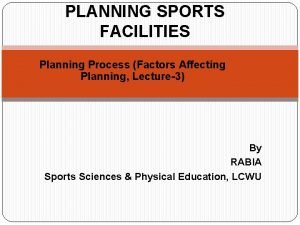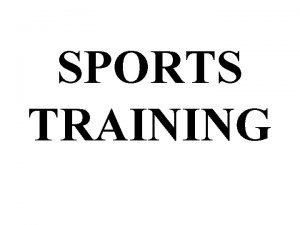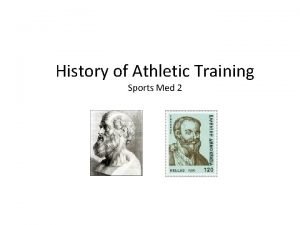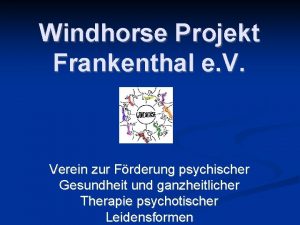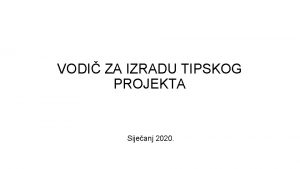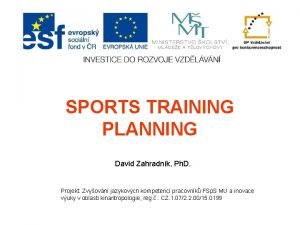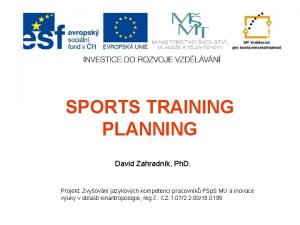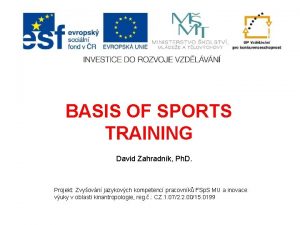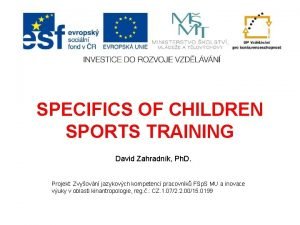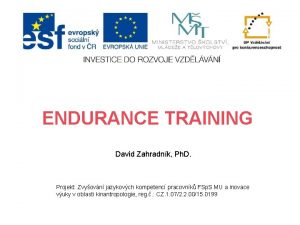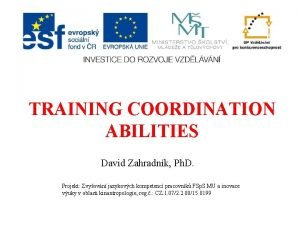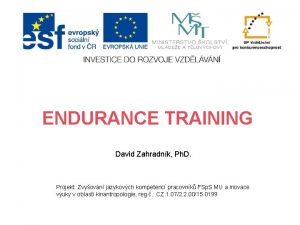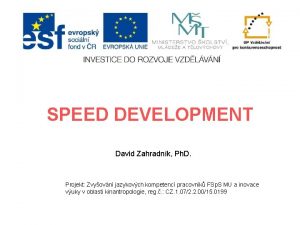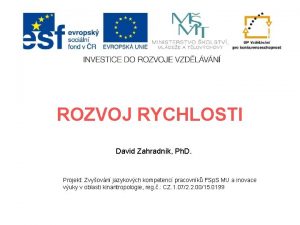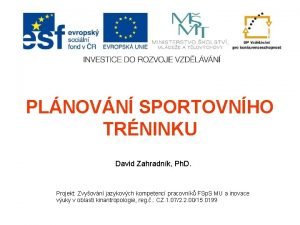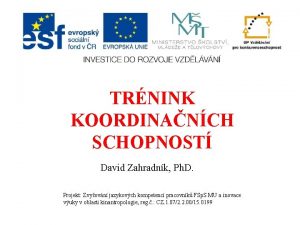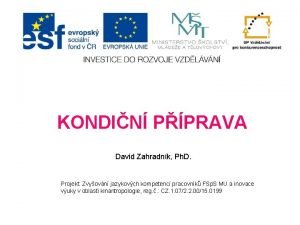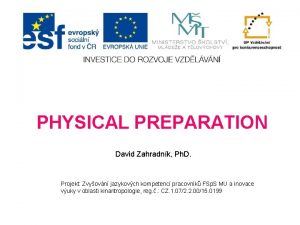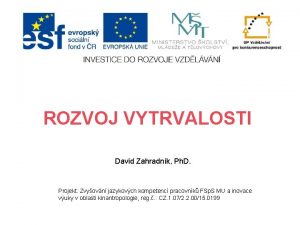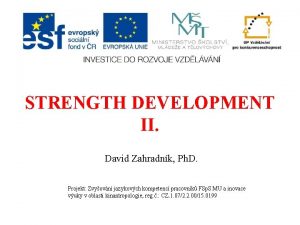SPORTS TRAINING PLANNING David Zahradnk Ph D Projekt

















- Slides: 17

SPORTS TRAINING PLANNING David Zahradník, Ph. D. Projekt: Zvyšování jazykových kompetencí pracovníků FSp. S MU a inovace výuky v oblasti kinantropologie, reg. č. : CZ. 1. 07/2. 2. 00/15. 0199

The beginnings of planning training Greek athlete Milon who implemented the principle of systematic planning as early as in the 6 th Century BC Hans Selye’s model, known as the General Adaptation Syndrome which was first used by the athletic community in the late 1950 s. eustress, which denotes beneficial muscular strength and growth distress, which is stress that can lead to damage, disease, and necrosis of tissue.

Periodization of sport training Periodization is a concept, not a model. It is a systematic attempt to gain control over training adaptive responses while preparing for a competition. Periodization is an organized approach to training which involves progressive cycling of various aspects of a training program during a specific period of time. In the periodization, the training process is distributed in time intervals, the magnitude of which may range from days to weeks, months or even years. During each of these time intervals, a particular element of performance is accented (e. g physical fitness, technique etc. )

Macrocycle The most recurrent cycle Not tied to a calendar year Period Main task of period Preparatory Developing fitness and training Pre-competition Tapering of performance Competition Maintaining high level of performance Transition Physical and psychic recovery

A traditional periodization scheme plans for one or few peaks , , peak, , is the aim of sports training (MS, game, etc. ) Mono-cycle (World Championship or Olympic Games) Bi-cycle (athletics) Tri-cycle (tennis) Multiple-cycle (competition in sports games)

Mono - cycle Prepraratory phase Competition p. Transition p. Bi - cycle Preparatory Competition Transition

Preparatory phase During this stage, the athlete gains required level of fitness and technical quality for the following periods. Analytic-synthetic character Two periods The first part is usually analytic, the training of motor abilities and technical and tactical skills is trained separately, the training mode is general and the load varies from low to medium, aiming at continuous development of performance. In the second part of this period, individual components are trained together, it is necessary to start to apply special training means; load is more intensive.

Pre-competition phase This period is included about 2 or 4 weeks before competitive period (season) and it should not be very long because it may result in decrease in motivation The main task is increasing performance The main principles of training in first transition period are: Decrease in training volume High quality of training process Sufficient time for rest and recovery Most training exercises are specific Check races or competitions

Competitive phase The main aim is to demonstrate the maximal level of performance During season, the athlete usually competes in top, most important or second-level competitions. In individual or endurance sports, this period is usually divided into two parts. In sports games only one part. Sports shape can be kept for about 2 or 4 weeks, therefore tapering for sports shape should be implemented for the main race only or twice during a long race season, with some recovery periods included between the periods of sports shape.

Transition phase relaxation periods This period usually lasts betwen 2 and 6 weeks, depending on the length of pre-competition and competition phase. Transition period is characterized with: Decrease in training load (intensity, volume, frequency). Training is based on general training means, however, it should be varied. Without competition. Attempt to maintain acquired level of fitness. Psychological recovery.

Training cycles basic components of periodization Macrocycle (2 mounts - 2 years) Mesocycle (2 – 6 weeks) Microcycle (1 week)

Microcycle is probably the most important tool in the planning of training. Mi. C is a group of several training units. Struktura a obsah týdenního mikrocyklu je určena hlavním tréninkových úkolem daného období RTC Mi. C type: Opening Developing (intensification) Stabilization Checking Tappering Racing Recovery

Mezocycle Partially correspond with parts of the macrocycle Opening mezocycle is used at the beginning of macrocycle. Basic Me. C is the main type for preseason First transition Me. C lasts for the whole first transition period. In-season Me. C is the basic type for in-season. Recovery Me. C contains a higher number of rest Mi. C.

Experience has shown that three weeks of increasing training load represents the usual limit of positive adaptation and the human ability to tolerate graded stress without signs of overtraining and fatigue accumulation. Me. C of the opening type for preparatory phase The basic type of Me. C for preparatory phase

Me. C of the pre-competition phase Me. C type for Season of individual sports Me. C type for Season of games

Makrocycle Create a system of annual training plan based on competition schedule and set the duration for individual periods. The set of objectives for individual periods of annaul macrocycle and for shorter time periods. Set the proportion of general, special and competition training means (for macrocycle as well as for periods). Set the number of training units. Set load volume and intensity for annual macrocycle and distributing load into individual periods.

Thank you for your attention
 Now group these activities into indoor and outdoor
Now group these activities into indoor and outdoor Factors that affect the planning process
Factors that affect the planning process Define sports training
Define sports training Herodicus of megara
Herodicus of megara Strategic planning vs tactical planning
Strategic planning vs tactical planning Goal achievement matrix
Goal achievement matrix Scenario planning workforce planning
Scenario planning workforce planning Inactivism planning
Inactivism planning Aggregate planning is capacity planning for:
Aggregate planning is capacity planning for: Short term planning and long term planning
Short term planning and long term planning Stages of language planning slideshare
Stages of language planning slideshare Aggregate planning is capacity planning for
Aggregate planning is capacity planning for Capacity aggregation example
Capacity aggregation example Training is expensive without training it is more expensive
Training is expensive without training it is more expensive Metode of the job training
Metode of the job training Aggression replacement training facilitator training
Aggression replacement training facilitator training Windhorse projekt
Windhorse projekt Tipski projekt primjer
Tipski projekt primjer

